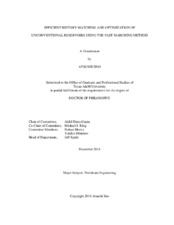| dc.description.abstract | For reliable performance assessment of unconventional reservoirs, we need to model the complex hydraulic fracture network that interacts with pre-existing/ induced fractures and reservoir rock, as well as the underlying physics such as gas desorption, Knudsen diffusion, phase behavior in nano-scale pores and stress-dependent fracture conductivity. Numerical simulation is a robust and versatile tool to incorporate relevant physics but the substantial computational time required can often be a bottleneck for the practical application.
Recently, a rapid simulation approach based on the Fast Marching Method (FMM) has been proposed. The high frequency asymptotic solution of the diffusivity equation leads to the Eikonal equation, which can be efficiently solved by the FMM for the Diffusive Time-of-Flight (DTOF) that governs the pressure ‘front’ propagation. The key concept of the FMM-based simulation is to utilize the DTOF as a 1-D spatial coordinate embedding reservoir heterogeneity to transform an original 3-D reservoir model into an equivalent 1-D model, leading to orders-of-magnitude faster computation compared to the normal finite difference simulation.
In this study, we first developed and validated the FMM-based blackoil simulation for multi-phase flow in unconventional reservoirs. We also present the field history matching example of Eagle Ford Shale to demonstrate the efficacy and utility of history matching workflow coupled with the FMM-based simulator, which assists in the
uncertainty assessment of reservoir and fracture properties as well as the production forecast.
Second, we further extended the FMM-based simulation to the multi-component compositional simulation. We propose a robust optimization workflow for the gas injection EOR in unconventional reservoirs. Use of the rapid FMM-based simulation enables a large number of Huff-n-Puff simulations with a field-scale reservoir model in a practical timeframe, which also provides us with comprehensive understanding on how each operational parameter influences the displacement and recovery processes.
Third, we adopted the FMM-based approach to multi-well simulations and optimization of the infill well spacing. The FMM-based simulation was extended to a multi-well scenario under the bottomhole pressure constraints. The computational efficiency of our approach enables extensive simulation runs to determine the point of diminishing return for additional well placement to obtain the optimal well spacing.
Lastly, we further extended the FMM-based multi-well simulation to the scenario of constant rate production where the drainage volume partition associated with each well dynamically changes over time. We proposed and validated new methodologies to appropriately model such dynamic partition changes. | en |


